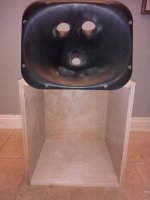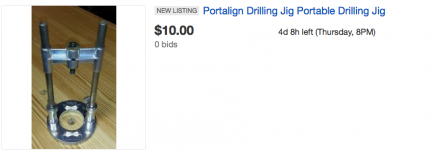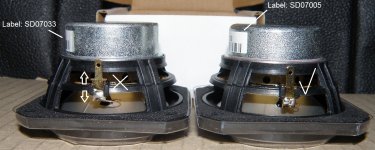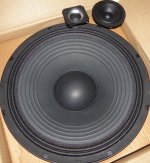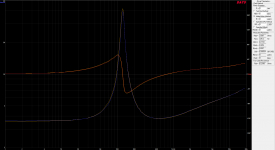Both projects are moving along quite nicely! Good job on the fix, X!
Thanks. I wasn't quite sure how well the fix would work and had my fingers crossed when taking the new measurements. The smaller holes amazingly don't limit the bass that much. It looks like maybe a 1dB drop in bass output with the smaller holes which have the equivalent area of a single 36mm hole.
I think I will 3D print a small drill template so that the holes for the other woofer look the same. Hand drilling without a template will not produce a result with 7 aligned holes like that.
I am falling behind - still don't have a box yet. If I make simple rectangular prismatic box - I have option of orienting speaker horizontally or vertically depending on need.
Being able to use the horn in the usual wider horizontal dispersion is a good idea.Thanks. I wasn't quite sure how well the fix would work and had my fingers crossed when taking the new measurements. The smaller holes amazingly don't limit the bass that much. It looks like maybe a 1dB drop in bass output with the smaller holes which have the equivalent area of a single 36mm hole.
I think I will 3D print a small drill template so that the holes for the other woofer look the same. Hand drilling without a template will not produce a result with 7 aligned holes like that.
I am falling behind - still don't have a box yet. If I make simple rectangular prismatic box - I have option of orienting speaker horizontally or vertically depending on need.
A template is a good idea.
The Portalign drill attachment a very useful tool when drilling deep holes that must be properly aligned, like your port holes or pole mount holes.
Attachments
xrk971 and bushmeister so far projects looks good 🙂
If you interested in trials to mod a SB65WBAC25-4 driver to see if small improvement can be find seems i got one we can play with and think of if we can improve a bit on waterfall in REW. Either i could do trials on a small OB where you suggest mods and i do them and publish measurements before and after, or i could send it to bushmeister and he could mod it.
Reason is received a pair before weekend where positive terminal on one of them was loose and rocking and Intertechnik via email told me they send one more for free on monday. 🙂 never had such a small full ranger in hand and couldn't resist compare dimensions to 10F/8424 and SPA-115PA.
Third picture is CSD SB65WBAC25-4 verse 10F8414G10 from here:
Test Bench - SB Acoustics SB65WBAC25-4 2.5? full-range driver | audioXpress
Test Bench - Scan-Speak 10F/8414G10 Small 3.5? Full-Range Woofer | audioXpress
If you interested in trials to mod a SB65WBAC25-4 driver to see if small improvement can be find seems i got one we can play with and think of if we can improve a bit on waterfall in REW. Either i could do trials on a small OB where you suggest mods and i do them and publish measurements before and after, or i could send it to bushmeister and he could mod it.
Reason is received a pair before weekend where positive terminal on one of them was loose and rocking and Intertechnik via email told me they send one more for free on monday. 🙂 never had such a small full ranger in hand and couldn't resist compare dimensions to 10F/8424 and SPA-115PA.
Third picture is CSD SB65WBAC25-4 verse 10F8414G10 from here:
Test Bench - SB Acoustics SB65WBAC25-4 2.5? full-range driver | audioXpress
Test Bench - Scan-Speak 10F/8414G10 Small 3.5? Full-Range Woofer | audioXpress
Attachments
I ended up using hot melt glue to fill the gaps and bond the insert to the horn. I was also able to shape the hot glue as it cooled to a pretty smooth profile. I then put a layer of black electrical tape over the glue for the joint temporarily for smooth transition.
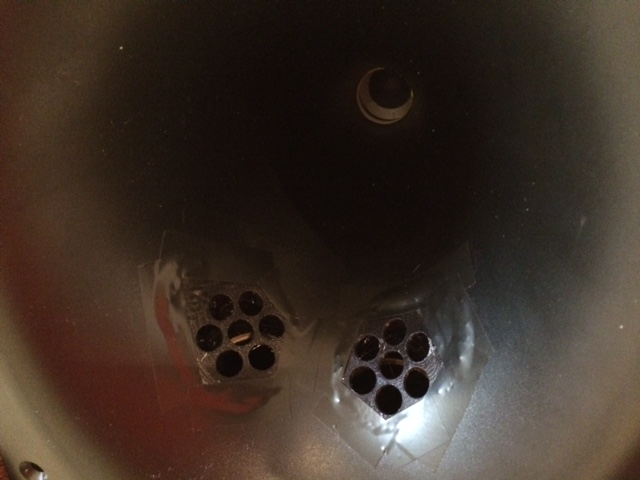
Measurements show that it was quite successful in boosting the output by about +2.5dB and smoothing it out - compared to taping over the holes to simulate a pristine horn.
I concentrated on the 30 deg measurement in detail to see this effect (red=big holes, blue=repaired, green=holes taped over):
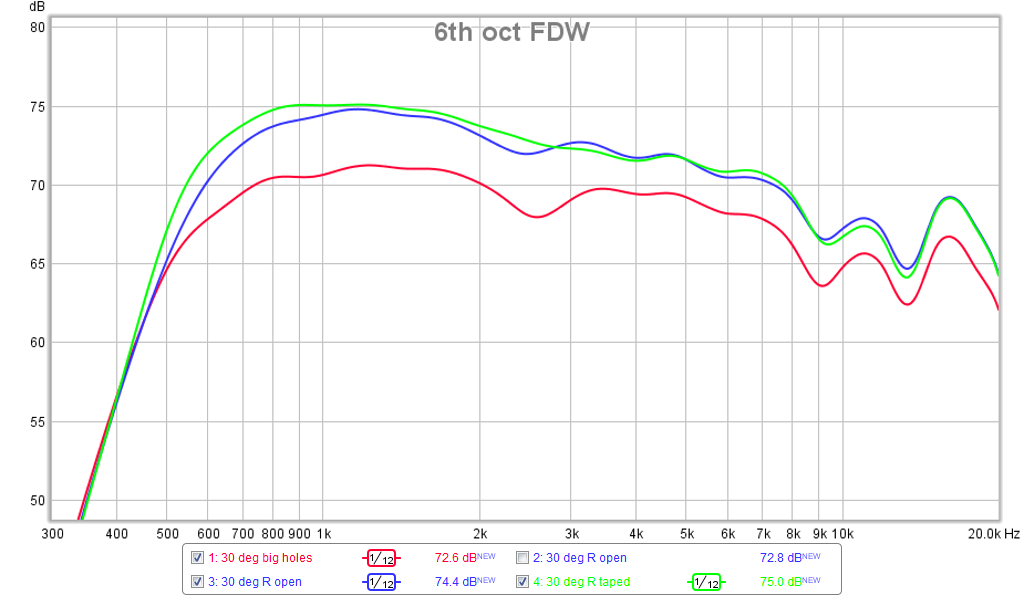
There is still a mild dip at 2.5kHz but the overall shape follows the pristine horn pretty well that I am satisfied with this performance. The taped over holes also has a bit more bass extension.
And here are polars with woofer running :
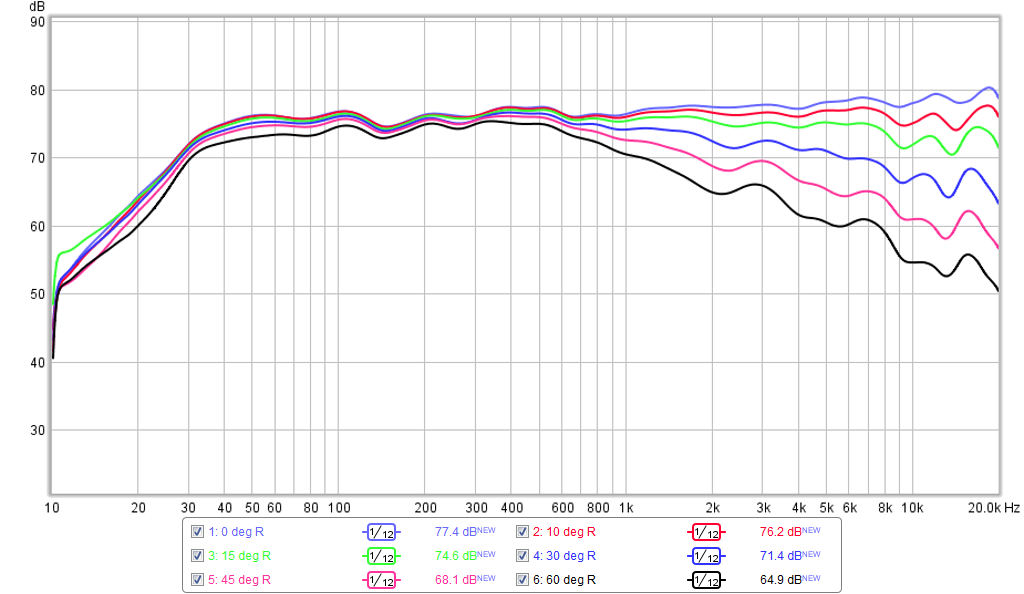
Hello X. Woow I see you've nailed it!

Good good good job!
Well done.
The bandpass with multiple holes show a great result.
Now you are a really nice polar responses.
Regarding the enclosure I wanted to mention some ideas (which might be suitable or not) but I think better worth sharing.
If we considere only fit to "passive" treatment I do not think there are too many possibilities if we desired contain enclosure overall volume and its dimensions to a compatible "bookshelf " format so I think could only be considered sealed boxes and for try improve bass response maybe having some kind of tuned bass port (front or rear).
They could also be considered (if a volume content could) build some kind of bass cardioid enclosure with a resistive box if we see that it could add and provide a real some improvement in directivity of pattern of the lower frequency spectrum.
For a more detailed idea about it add a link with a diy project and where the builder describes some about.
Cardioid bass
That cardiod bass resistive enclosures seems are based on a job from Juha Backman :
"Juha Backman, Theory of Acoustical Resistance Enclosures, 106th AES Convention, 1999, Munich, Preprint 4979"
Finally if we consider the "active" possibilities (if you choose to use a DSP for XO and / or EQ) this open other multiple options as add dampping and delaying back signal from drivers. But I think this option (digital processing for bass improvement) is so so large and with so many possibilities as to describe much more now.
Regards
Last edited:
Well done X!
Progress is being made here too..
Hi Bush.
Is that (lower wood case) the enclosure you build for the horn?
Anyway looks good !
Regards
Last edited:
Jirm,
Thanks for the enclosure suggestions. The cardiod is interesting and I think may be similar to what I am hearing with blankets wrapped on the back. It gets deep bass extension in the near field but far away it drops off. The ported bass reflex is a no no as I am aiming for transient perfect speakers - or at least one without the phase turn of a reflex port. Sealed or leaky open back it will be most likely.
Thanks for the enclosure suggestions. The cardiod is interesting and I think may be similar to what I am hearing with blankets wrapped on the back. It gets deep bass extension in the near field but far away it drops off. The ported bass reflex is a no no as I am aiming for transient perfect speakers - or at least one without the phase turn of a reflex port. Sealed or leaky open back it will be most likely.
xrk971 and bushmeister so far projects looks good 🙂
If you interested in trials to mod a SB65WBAC25-4 driver to see if small improvement can be find seems i got one we can play with and think of if we can improve a bit on waterfall in REW. Either i could do trials on a small OB where you suggest mods and i do them and publish measurements before and after, or i could send it to bushmeister and he could mod it.
Reason is received a pair before weekend where positive terminal on one of them was loose and rocking and Intertechnik via email told me they send one more for free on monday. 🙂 never had such a small full ranger in hand and couldn't resist compare dimensions to 10F/8424 and SPA-115PA.
Third picture is CSD SB65WBAC25-4 verse 10F8414G10 from here:
Test Bench - SB Acoustics SB65WBAC25-4 2.5? full-range driver | audioXpress
Test Bench - Scan-Speak 10F/8414G10 Small 3.5? Full-Range Woofer | audioXpress
Nice one on getting a free SB65! What do you propose to do to bring HD or CSD down?
Nice one on getting a free SB65! What do you propose to do to bring HD or CSD down?
Wasn't it FR58EX and FR88EX you experienced better dampened and suspects it was rubber surround that extend into alu cone, in that manner think of some strategic placed acrylic paint that can be scraped/washed of again. Thought is not to change response as think was purpose with your PA130 mod, think more of small dampen changes to get bit cleaner CSD decay and mayby IR if possible.
Acrylic paint is a good idea. Maybe even latex caulking or rubber cement may work at the interface of the surround and the cone.
xrk971 and bushmeister so far projects looks good 🙂
If you interested in trials to mod a SB65WBAC25-4 driver to see if small improvement can be find seems i got one we can play with and think of if we can improve a bit on waterfall in REW. Either i could do trials on a small OB where you suggest mods and i do them and publish measurements before and after, or i could send it to bushmeister and he could mod it.
Reason is received a pair before weekend where positive terminal on one of them was loose and rocking and Intertechnik via email told me they send one more for free on monday. 🙂 never had such a small full ranger in hand and couldn't resist compare dimensions to 10F/8424 and SPA-115PA.
Third picture is CSD SB65WBAC25-4 verse 10F8414G10 from here:
Test Bench - SB Acoustics SB65WBAC25-4 2.5? full-range driver | audioXpress
Test Bench - Scan-Speak 10F/8414G10 Small 3.5? Full-Range Woofer | audioXpress
The terminals on one of my SB65s fell off too.
To everybody posting: You've gone and done it! I have a JBL 2365 horn. As SR. Bateman is aware I have been messing with Paralines to the point of build ing a prototype of something strange that doesn't sound too bad...
Now I have to fire up the computer and get the Paraline Substitution for the 2365 horn throat parts drawn and then I'll be back to get help with adapting two 15" woofers to the horn ala Synergy. Goodness what have you DONE!
Now I have to fire up the computer and get the Paraline Substitution for the 2365 horn throat parts drawn and then I'll be back to get help with adapting two 15" woofers to the horn ala Synergy. Goodness what have you DONE!
Jirm,
Thanks for the enclosure suggestions. The cardiod is interesting and I think may be similar to what I am hearing with blankets wrapped on the back. It gets deep bass extension in the near field but far away it drops off. The ported bass reflex is a no no as I am aiming for transient perfect speakers - or at least one without the phase turn of a reflex port. Sealed or leaky open back it will be most likely.
Hello X.
I am glad that my suggestions can be used for something. 😱
Totally agree that all ported boxes introduced "ugly" issues on phase response but too I think in many cases are easily correctable mainly if are able for go with XO/EQ via DSP that I personally think is the right route for all build speakers on today.
Anyway it is clear that the results box "type" OB or good sealed one may be optimal since the horn response itself is really excellent without need improve anything so much.
Lastly if someone serves as inspiration and following that I say about ported resistive exclosures I forget before what "I think" a derivative of such resistive boxes that are called aperiodic enclosures.
For more info about I add a link with the description of the concept.
http://diyaudioprojects.com/Technic...ize-with-Better-Low-Frequency-Performance.pdf
And in this one diy implementation link to get an idea of proper implementation of the concept.
http://www.frugal-phile.com/box-plans/p10-4L-aperiodic.gif
Everything I said is based on finding box designs have been proven correct for good results with a low-volume or tiny-dimensions enclosures designs.
Regards
Last edited:
To everybody posting: You've gone and done it! I have a JBL 2365 horn. As SR. Bateman is aware I have been messing with Paralines to the point of build ing a prototype of something strange that doesn't sound too bad...
Now I have to fire up the computer and get the Paraline Substitution for the 2365 horn throat parts drawn and then I'll be back to get help with adapting two 15" woofers to the horn ala Synergy. Goodness what have you DONE!
Nice! That's a big horn and some big woofers! What does a Paraline have to do with it? You won't be using a fullrange cone driver?
http://www.jblpro.com/pub/obsolete/23606566.pdf
There's lot of real promising stuff going on here, and the rough measurements look petty good. That said.......how about some gated, unsmoothed data? I've seen some clean impulses here out to 4ms+ which would be sufficient for hi-res data from 1.5-2khz up.
It's easy to say that the fdw is a close approximation of our hearing (I'm not so sure about that) but I think the gated data would better show what's actually going on. IMO the fdw is for in room measurements from the lp to get an idea of the response, and clearly it has a significant smoothing effect. I do think in this case (in room measurement from the lp) that the fdw is a better approximation of our hearing vs a smoothed steady state measurement. I use it for speaker measurements below 1khz but only to get an idea of the level in relation to the hf response and maybe for rough xo work down low.
It's easy to say that the fdw is a close approximation of our hearing (I'm not so sure about that) but I think the gated data would better show what's actually going on. IMO the fdw is for in room measurements from the lp to get an idea of the response, and clearly it has a significant smoothing effect. I do think in this case (in room measurement from the lp) that the fdw is a better approximation of our hearing vs a smoothed steady state measurement. I use it for speaker measurements below 1khz but only to get an idea of the level in relation to the hf response and maybe for rough xo work down low.
There's lot of real promising stuff going on here, and the rough measurements look petty good. That said.......how about some gated, unsmoothed data? I've seen some clean impulses here out to 4ms+ which would be sufficient for hi-res data from 1.5-2khz up.
It's easy to say that the fdw is a close approximation of our hearing (I'm not so sure about that) but I think the gated data would better show what's actually going on. IMO the fdw is for in room measurements from the lp to get an idea of the response, and clearly it has a significant smoothing effect. I do think in this case (in room measurement from the lp) that the fdw is a better approximation of our hearing vs a smoothed steady state measurement. I use it for speaker measurements below 1khz but only to get an idea of the level in relation to the hf response and maybe for rough xo work down low.
Nate, think about it... how long does a note last at say 6000 Hz. Would you really listen to that note with a 4 ms window? Or will it be over in just over 1 ms and all you see after that is the decay trail.
The frequency dependant window isn't useful for in room measurements only. It is useful for speaker correction only. That's what we want to do here. You don't want other stuff in that measurement at higher frequencies. Hence you look at what it is that gets interpreted by your ears. A longer gate and EQ decisions based on that give you pretty graphs. But wouldn't you rather have pretty sounds?
If nothing upsets the signal after the frequency dependant window, the resulting graph gated at 4 ms will still be as clean. But do not try and make EQ decisions on higher frequencies with too long of a window. It will only make the graphs pretty.
Seriously think about how that note is played, then decays into the noise floor.
It's the difference between room correction and speaker correction. What we want here is speaker correction. Frequency dependant windows give you that.
They might look smoothed to you, the band pass nature of it does smooth it but figure out what you actually hear and it will start to make sense.
Hope this helps.
There's lot of real promising stuff going on here, and the rough measurements look petty good. That said.......how about some gated, unsmoothed data? I've seen some clean impulses here out to 4ms+ which would be sufficient for hi-res data from 1.5-2khz up.
It's easy to say that the fdw is a close approximation of our hearing (I'm not so sure about that) but I think the gated data would better show what's actually going on. IMO the fdw is for in room measurements from the lp to get an idea of the response, and clearly it has a significant smoothing effect. I do think in this case (in room measurement from the lp) that the fdw is a better approximation of our hearing vs a smoothed steady state measurement. I use it for speaker measurements below 1khz but only to get an idea of the level in relation to the hf response and maybe for rough xo work down low.
I agree with Wesayso but if you are really curious, the HD plots typically show *ungated* frequency response for the fundamental. For example, here is the response from the SB65 and LTH142 at 0.5m ungated and 1/12th octave averaged. I think this particular plot was with a LR4 HPF at 500Hz.
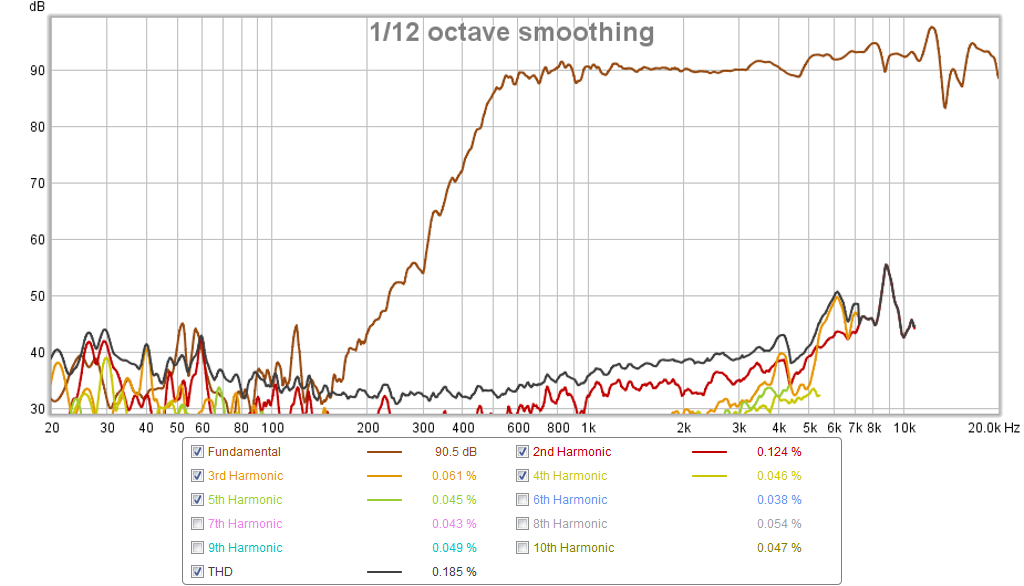
It's not bad and the EQ based on 1/6th FDW was what was used to base the EQ on and it turned out nicely I think.
Last edited:
- Home
- Loudspeakers
- Multi-Way
- A Bookshelf Multi-Way Point-Source Horn
